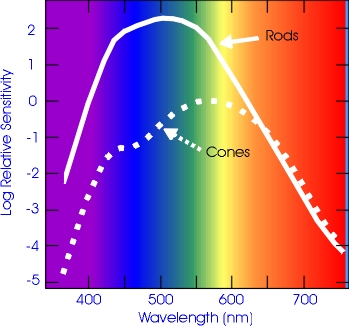 In a previous section of this book, I pointed out that in dim light and
dark adapted conditions, our rod receptors are more sensitive
than our cone receptors. As can be seen in the figure on the
right, the peak sensitivity of the rods occurs at shorter wavelengths than does the peak
sensitivity of the cone receptors.
In a previous section of this book, I pointed out that in dim light and
dark adapted conditions, our rod receptors are more sensitive
than our cone receptors. As can be seen in the figure on the
right, the peak sensitivity of the rods occurs at shorter wavelengths than does the peak
sensitivity of the cone receptors.
At high levels of illumination the rods receptors saturate. Saturation means that
after a certain level of illumination the rod responses cease to increase even though the
illumination levels continue to increase. If you place a horizontal straight
edge near log sensitivity of -1 and lay it across the graph you will see that the cones
have approximately the same sensitivity to blue (near 450 nm) as they do to red (near 650
nm). So at high levels of illumination where the rods are saturated it is not
difficult to adjust a blue and red light to be approximately equal in brightness.
If we now reduce the illumination to near cone threshold we enter the range called
mesopic vision, where the rods exhibit considerably sensitivity and we are still above
cone threshold. Since the rods are much more sensitive to short wavelengths than are
the cones these wavelengths will appear brighter. If the illumination is reduced to
below cone threshold color vision will disappear and because the rods are more sensitive
to short wavelengths than to long ones, blue colors will appear brighter, albeit,
colorless.
Table of Contents
Subject Index
Table of Contents [When not using frames]
 In a previous section of this book, I pointed out that in dim light and
dark adapted conditions, our rod receptors are more sensitive
than our cone receptors. As can be seen in the figure on the
right, the peak sensitivity of the rods occurs at shorter wavelengths than does the peak
sensitivity of the cone receptors.
In a previous section of this book, I pointed out that in dim light and
dark adapted conditions, our rod receptors are more sensitive
than our cone receptors. As can be seen in the figure on the
right, the peak sensitivity of the rods occurs at shorter wavelengths than does the peak
sensitivity of the cone receptors.